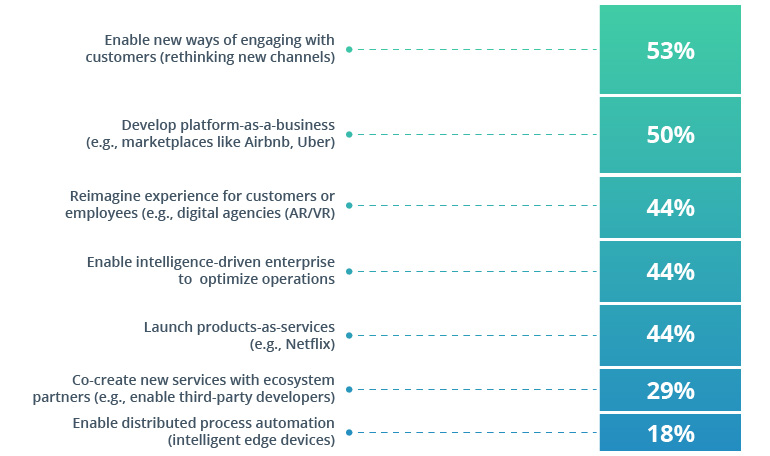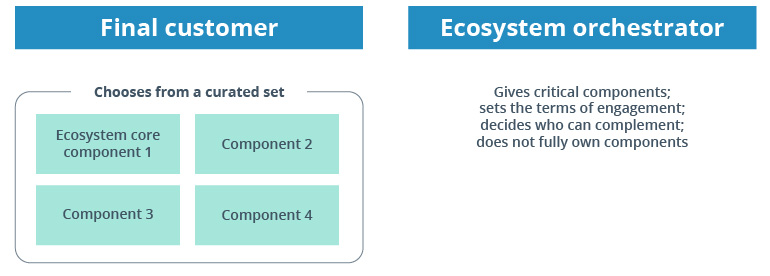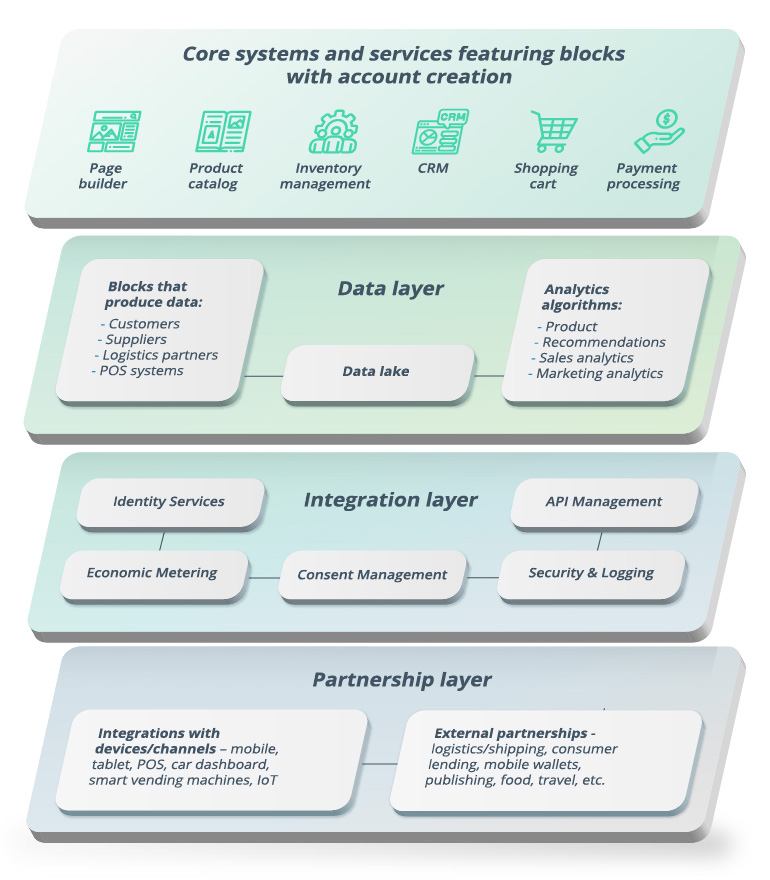At the dawn of smartphones, Blackberry was the ultimate executive dream toy. In 2009, the company held 20% of the global market share (and nearly 50% of the market share in the US), coming second to Nokia (Symbian). Mind you, Steve Jobs had already launched the iPhone two years before, and Android had been live since 2008.
In 2014, on its 10th anniversary, Blackberry slid to holding a 0% market share in the US. Yikes! Not the best gift.
The global prognosis for mobile operating system growth between 2018 and 2024 looks like this:

Source: IDC — Smartphone Market Share
That’s a one-chart illustration of how platforms beat products.
Outside of smartphones, platform-based business models dominate 75% of the time across products and sectors in developed economies.
So does the platform business model promote the survival of the biggest and the fittest, leaving no room for smaller competitors?
Not entirely. While Google, Apple, Facebook, and Microsoft are among the most well-known digital platforms, they aren’t the only movers and shakers.
What is a platform in the business and technical senses? Why do so many companies aspire to become platforms? Let’s get into those answers and more!
What is a platform business model?
A platform technology business model is hardly new. An art auction, a weekly co-op market, and a theme park are simple examples of platform-based business models if you look at them from the right angle.
The key components of a platform business are:
- Infrastructure: A farmer’s market with stalls and a management office
- Producers: Farmers and other vendors
- Consumers: Local foodies
- Value proposition: Facilitate product exchanges between producers and consumers
- Monetization strategy: The co-op takes a percentage of all sales
The platform as a service business model does not own the means of production, but rather creates and facilitates the means of connection.
The digital component of the platform magnifies its network effect. Instead of dealing with several partners and proposing several offerings within one vertical (e.g. food), digital platform models help scale and streamline the governance of all platform participants, making it easier to facilitate and optimize interactions across a wide range of participants so that everyone involved maximizes the values they produce and receive.
For example, in a “connected farmers market”:
- Fishmongers could team up with vegetable and spice sellers to run bundled deals. A shopper could buy a discounted meal kit and not fret about deciding what’s for dinner.
- Regulators could easily receive data about produce provenance, freshness, and overall compliance with quality standards. With data collected automatically, farmers wouldn’t need to fill in paper-based forms, while consumers could be assured that quality standards were met.
- The co-op could streamline payment collection from vendors, suggest better pricing strategies based on consumer data, and seamlessly onboard new participants to meet increased demand. Also, they could take over fulfillment and delivery for online orders by building an integrated eCommerce platform and plugging in shipping partners.
But what about platforming in a technical sense, not in the business one?
A digital platform is an open architecture structured to connect previously disparate systems, applications, data streams, and service providers into an ecosystem, driving more value for the end customer.
Such togetherness promotes greater growth prospects, sparks innovation among participants, and results in a higher degree of relevance and personalization for consumers.
The personalization aspect is particularly important, as with a digital business platform companies can satisfy a wide range of customer needs with solutions that are tightly aligned with customer journeys at different life stages. This drives ongoing platform use, loyalty, and profitability.
Millennials expect their financial institutions to ‘get them’ – to understand their unique life situation and goals at a given moment, not to pitch generic services based on their age, income, or buyer persona.
The optimal platform-based business model enables companies to deliver a range of highly relevant value propositions to consumers by leveraging the data they own with services they obtain via ecosystem partners.
What’s so good about having a platform-based business model?
Depending on the operating model, platform businesses can achieve growth and scale faster than other businesses in several ways:
1. By minimizing the cost of production/service delivery.
Unlike traditional product companies, in the early days, platform businesses shift production to third parties. Alibaba started as an eCommerce marketplace, with most products listed and shipped by non-professional sellers (C2C). Uber didn’t own vehicles — they just provided value-added services.
As they were not constrained by the cost of production, such platform economy startups could scale faster than non-platform and then reinvest profits into extra services or in-house product development. Uber eventually purchased a fleet of cars to lease to drivers (B2C) and created an integrated driver wallet (B2B).
Alibaba branched into the financial space, launching Ant Group subsidiary (B2B & B2C) backed by a portfolio of other products they developed as well as payment and consumer data they’ve accumulated.
Even better, incumbent product firms can also adopt a platform as a service business model.
Walmart has teamed up with Shopify — a popular eCommerce website builder among SMBs — to enable easier integration with their growing eCommerce arm. As of 2020, the marketplace accounts for 90% of Walmart’s total SKUs, and this growth was achieved without taking extra inventory risks.
2. To leverage economies of scale and the network effect.
With more consumers participating in an ecosystem, more producers are inclined to join and the total value proposition increases.
This enables companies with cross-platform business models to branch out and produce more goods or services at a lower input cost.
Combined, these two factors create a sticky effect: consumers return to platforms over and over to benefit from the consolidated offerings. Meanwhile, platform businesses, depending on their operating model, can further drive growth by:
- Launching a marketplace extension and capitalizing on increased transaction fees. Example: marketplace banking
- Renting out the same infrastructure (e.g. the core banking platform) as a platform as a service offering. Example: mobility as a service solution
- Branch out into new sales channels, business models, markets, and business verticals to attract more consumers. Example: in-car commerce
How companies benefit from digital platforms

Source: Accenture — Digital platforms will define the winners and losers in the new economy
3. By accumulating customers across verticals with a digital platform business model.
Melding cloud computing, a microservices architecture, and a formalized API strategy with a strong data governance framework and advanced big data analytics, digital platform businesses can consolidate monolithic services into an integrated offering.
Alternatively, or on top of that, strategic platform building enables faster penetration into new verticals with a lower chance of failure. You can leverage the existing customer base (and the data you have about them) to foster early adoption.
That’s what Ping An did. Five years ago, the legacy Chinese insurer started building a platform of services related to different aspects of consumers’ lives. Rather than trying to directly sell insurance products to customers, they’ve focused on eliminating friction associated with common insurance use cases — going to the doctor, starting a business, or buying a new car. Ping An embarked on insurance software development to launch 11 integrated digital engagement platforms (including a standalone banking service and lending platform) across different verticals. Their online medical service, connecting patients with doctors and upselling insurance products, had amassed over 364 million users as of mid-June 2020.
We’ve created this virtual cycle, whereby our customers have developed some affinity with us, and naturally buy from us. We think this ecosystem model is much better than a more traditional one where a customer has to buy a product first and then you provide services based on that customer’s needs.
How to build a platform, one layer at a time
Platforms have a modular architecture, where each service component functions as a pluggable block you can use to create different product combinations.
Ecosystem-based structure to balance flexibility and control

Source: Weforum — Platforms and Ecosystems: Enabling the Digital Economy
As the platform owner, you assume the role of an orchestrator — the central authority who decides how different resources are used and which combinations of resources can be leveraged to drive value for end consumers.
The services under your governance can be internal (such as native platform features) or API-based services and components built by others but used by you. The bigger the platform, the more moving parts and possible entropy, as you need to control both your own resources and those provided by others.
Things can quickly get messy without platform orchestration — automatic coordination and management of all systems.
But what are these systems exactly? Let’s look closer.

Source: Accenture — Journey to a Platform Economy
Core systems and services layer
A lot of incumbent companies have a rigid core — a monolithic platform delivering a fixed range of services. It’s resistant to change, hard to obtain data from, and well overdue for modernization.
Unlike legacy systems, platforms consist of loosely coupled microservices. Core business services that are modular and reusable can be embedded into an array of business applications via internal APIs. Or they can be distributed externally (again as APIs) to others the way “as a service” platforms do.
Apart from core in-house offerings, platforms host an array of software, systems, and ready-to-use products from third-party developers. For example, the digital bank Revolut uses Fireblock’s MPC-based wallet and network infrastructure to support the introduction of new cryptocurrency services (inward growth). And the Green Dot banking as a service platform scored them deals with Apple, Intuit, and Uber among others (outward growth).
But why rent the infrastructure for core services instead of building it yourself? Well, for startup platforms, the cost of developing a custom payment processor may not be feasible at the early-growth stages. And why bother when there are plenty of off-the-shelf integrations available to accelerate the time to market?
More mature players shouldn’t rush to buy a piece of tech either. Instead, platform businesses can play the waiting game and observe how an external player drives profit and value before deciding to acquire or replace them with custom software.
Data and analytics layer
Business platforms capitalize on data they accumulate, analyze, and classify to properly connect people, processes, and assets.
One of our clients, the first provider of digital banking services in Germany, originally launched a free online community where people received rewards for evaluating financial products. Using data obtained from this community (and the power of the network effect), the company first launched a dedicated payment service, and afterward a digital banking platform. Our team has helped them build a cloud-based data management solution to aggregate, store, and analyze large volumes of data from different sources and leverage it for future product development.
While digital business platforms evolve in different ways, most have the following elements within their data layer:
- A data ingestion mechanism
- A data lake storage platform
- A rule-based or ML-based analytics engine
Integration layer
Platforms also need a connector enabling all players to communicate with one another without any friction.
At this stage, you’ll need to create a strategy for:
- Identity management: single sign-on for users and ecosystem participants
- Platform security management so that no endpoint is left unprotected
- API management to orchestrate interactions among all parties
Partnership Layer
Core services, embedded microservices, a data layer, and APIs comprise the underlying modular infrastructure for a digital experience platform.
Once that’s figured out, you can look into ways to grow beyond your initial business vertical. By reusing different core service components and onboarding new partners, you can:
- Deploy complementary services (Booking.com: hotels => car rentals, flights, taxis, tours, etc.)
- Embrace new channels and devices (Amazon: eCommerce platform => cloud services, fulfillment and warehousing services, unattended retail)
- Enable external partners to build products on top of your platform (Facebook: social media network => Facebook apps, Facebook Shops, Messenger Chatbots)
- Scale value by branching into new service verticals (WeChat => payment services, banking services, health and lifestyle services
Don’t forget to add the secret sauce
Every successful platform as a service business model has a secret sauce — an unfair advantage setting them ahead of the competition.
- Can you solve a certain customer pain point better than others?
- Can you address issues others in your field are yet to explore?
- Can you run better analytics?
- Do you have more mature AI capabilities?
When you’re running a platform with many push and pull forces, it’s easy to drift away from your core vision, leading to subpar product development decisions. Build a strong core first and then move into extra opportunities for value creation.
Contact Intellias to learn more about platform development. From discovery sessions to data strategy and infrastructure implementation, we’re ready to support your platformization journey



